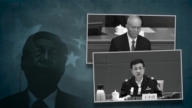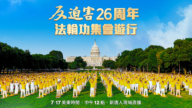【新唐人2013年03月29日讯】近一段时间以来,中国南海领土争端再次升级,越南指责中共军舰在两国有争议的海域,枪击越南渔船。中共喉舌《环球时报》发表评论文章,否认越南的指责,同时却曝光了前中共党魁江泽民,将白龙尾岛割让给越南的卖国行为。请看本台记者的报导。
针对越南指责中国船舰枪击越南渔船一事,大陆外交部26号回应宣称,中方行动属必要、正当。
但《环球网》披露:中越在北部湾海上划界时,中国将历史上本来属于中方的白龙尾岛让给了越方。
翻开历史,60年代美越战争期间,中共党魁毛泽东和周恩来同意将白龙尾岛划入越南领土。而在70年代中期,越南开始对南中国海的西沙群岛、南沙群岛提出领土主权要求,占领了南沙群岛的多个岛屿。
90年代后,围绕南海海洋权益的争端日益尖锐。南海争端成为中共与东盟国家之间的突出问题。
从1992年到2000年,中越双方共举行了7轮政府级谈判,3次政府代表团团长会晤、18轮联合工作组会谈。2000年12月25号,中越双方签署《北部湾划界协定》,和关于中越北部湾渔业合作的《渔业协议》。其中,将浮水洲岛(就是越南所称的白龙尾岛)正式割让给越南。
白龙尾岛是南海诸岛中,面积最大的岛屿,约有9.96平方公里。是太平岛的2倍,永兴岛的4倍。
白龙尾岛被永久割让给越南,导致广东附近传统作业渔场减少了3万2千平方公里,约占传统作业渔场的50%﹔并进一步加剧了北部湾中心线以东的渔业资源争夺。
而签署这一协定的,正是当时的国家主席江泽民。
美国乔治梅森大学教授章天亮表示,江泽民秘密签署协议,出卖领土,属于卖国行为。那么,为什么江泽民要出卖中国的领土给俄国呢﹖
章天亮:“共产主义在国际上是名声很坏,而且是相当的孤单,像江泽民他为了在联合国,或者是在其他别的一些议题上,希望能够得到一些国家的支持,那么,除了经济援助之外,无偿的把中国领土割让给他们,这是江泽民和邻国搞好关系的一个做法。”
原美国纽约州立大学教授谢选骏也表示,中共为了跟邻国搞好关系,不惜割让土地,来保住自己的政权,而不是保护自己国家民族的利益。谢选骏提醒,江泽民不只送出一个“白龙尾岛”,他还给俄国划出大批土地。
谢选骏:“江泽民割让领土给俄国,是因为它比较亲俄,因为它在俄国待过嘛,它是苏联培养的,所以它把领土割让给苏联,他感觉就好像是给了他娘家似的。把中国的领土不当回事,就拿了给外国。”
据了解,江泽民在1991年、1994年、1999年、2001年分别和俄国签署协定书,以条约形式肯定国界线。而这些条约,等于江泽民默认了沙皇和满清签署的九项不平等条约。
有分析指出,这些条约使中国永远丧失了约160万平方公里的土地,还不包括外蒙。其中,新疆与俄罗斯交叉口附近、靠近外蒙古和俄罗斯的黑龙江最西部、黑龙江和吉林北部交界处、以及乌苏里江、图们江出海口北部等,全都划给了俄罗斯。
另外,有关这些条约的签定,中共当局只在《人民日报》作出简短的报导,声明两国圆满解决了边界问题,却没有提及条约的内容。
采访编辑/常春 后制/陈建铭
Exposing Jiang Zemin’s Scandals
Recently, South China Sea territorial disputes escalated again.
Vietnam accused Chinese Communists Party (CCP) warships
of attacking their fishing boats in disputed waters
between the two countries.
CCP’s mouthpiece, the Global Times, published
commentary denying the accusations.
At the same time, it exposed the former CCP leader,
Jiang Zemin, who ceded Bailongwei Island to Vietnam.
On March 26, China’s Ministry of Foreign affairs claimed
that shooting Vietnamese fishing boats was necessary and legitimate.
Yet, the Global Times disclosed, “During Mao’s era,
the CCP agreed to give up Bailongwei Island, which was rightfully China’s territory.”
During the US-Vietnam War in the 1960s, the CCP leaders
Mao Zedong and Zhou Enlai agreed that Vietnam could claim Bailongwei Island as its territory.
In the mid-1970s, Vietnam began to demand Paracel Islands
and Spratly Islands in the South China Sea, and occupied some parts of the Spratly Islands.
In the 1990s, the dispute over islands in the South China Sea
became increasingly sensitive.
It was an obvious issue between the CCP and the ASEAN
countries.
From 1992 to 2000, the CCP and Vietnam held seven
government-level negotiations, in addition to meeting
with heads of the government delegation three times,
and had 18 joint working group talks.
December 25, 2000, the two sides signed
the Sino-Vietnamese Beibu Gulf Demarcation Agreement
and the Fisheries Agreement regarding
the Beibu Gulf Fishery Cooperation.
In these agreements, Bailongwei Island
was officially ceded to Vietnam.
Bailongwei Island is the largest island in the
South China Sea, at nearly 4 square miles.
It is twice the size of Taiping Island,
and four times that of Yongxing Island.
Without Bailongwei Island, the traditional fishing ground
near Guangdong was reduced by 11,584 square kilometers,
which is about 50% of the traditional fishing ground.
It has also further exacerbated the competition for fishery
resources east of the centerline of the Beibu Gulf.
These agreements were signed by the former president,
Jiang Zemin.
Professor Zhang Tianliang at George Mason University
thinks that Jiang Zemin signed secret agreements and gave up China’s territories.
That was the behavior of a traitor.
But why did he give up China’s territories to Russia?
Zhang Tianliang: “At that time, communism acquired
a bad name and was quite isolated internationally.
Jiang Zemin wanted support from other countries regarding
the United Nations and some other issues.
He thought giving up China’s territories in addition
to financial help would bring a good relationship with neighboring countries.”
Xie Xuanchun, a former professor of New York State
University: “Jiang did it to safeguard his own power instead of China’s best interests.
Jiang gave up not only Bailongwei Island but also a large
piece of land to Russia.”
Professor Xie Xuanchun: “Jiang Zemin ceded territory
to Russia, because he was relatively pro-Russian.
He stayed in Russia and was trained there.
So, China’s territories meant nothing to him,
but sending a gift to Russia was natural.”
It is understood that Jiang Zemin signed agreements
with Russia in 1991, 1994, 1999, and 2001, respectively.
Demarcation of boundaries was included in
the form of a treaty.
These treaties were equivalent to Jiang Zemin’s consent
to the nine unequal treaties signed by the Tsar and the Manchu.
Some analysts pointed out that China lost 1.6 million square
kilometers of land in these treaties, not including Outer Mongolia.
The intersection of Xinjiang and Russia, near the intersection
of Heilongjiang West, Outer Mongolia and Russia,
the northern junction of Heilongjiang and Jilin, the Ussuri
River, and Tumen River estuary north, were all allocated to Russia.
Regarding the signing of these treaties, People’s Daily
only made a brief report that the CCP had reached
a satisfactory bilateral solution to the border issue,
but did not mention the content of the treaties.




























